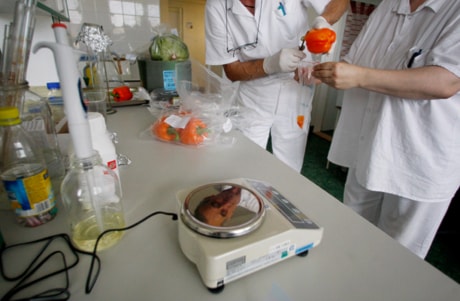BERLIN — The number of people hit by a massive European outbreak of foodborne bacterial infections is one third higher than previously known and a stunningly high number of patients suffer from a potentially deadly complication than can shut down their kidneys, officials said Wednesday.
The death toll rose to 17, with German authorities reporting that an 84-year-old woman with the complication had died on Sunday.
Medical authorities appeared no closer to discovering either the source of the infection or the mystery at the heart of the outbreak: why the unusual strain of the E. coli bacteria appears to be causing so many cases of hemolytic uremic syndrome, which attacks the kidneys and can cause seizures, strokes and comas.
“This particular strain we’re dealing with now seems to be unique,” said Dr. Hilde Kruse, program manager for food safety at WHO Europe:
Germany’s national health agency said 1,534 people in the country had been infected by EHEC, a particularly deadly strain of the common bacteria found in the digestive systems of cows, humans and other mammals.
The Robert Koch Institute had reported 1,169 a day earlier.
The outbreak has hit at least nine European countries but virtually all of the sick people either live in Germany or recently travelled there.
The Robert Koch Institute said 470 people in Germany were suffering from hemolytic uremic syndrome, or HUS, a number that independent experts called unprecedented in modern medical history. HUS normally occurs in 10 per cent of EHEC infections, meaning the number seen in Germany could be expected in an outbreak three times the size being currently reported.
That discrepancy could indicate that a vast number of cases haven’t been reported because their symptoms are relatively mild, medical experts said.
But they also offered another, more disturbing theory — the strain of EHEC causing the outbreak in Europe could be more dangerous than any previously seen.
“There may well be a great number of asymptomatic cases out there that we’re missing. This could be a much bigger outbreak than we realize right now,” said Paul Hunter, a professor of health protection at the University of East Anglia in England.
“There might also be something genetically different about this particular strain of E. coli that makes it more virulent.”
There are hundreds of different E. coli strains in the environment — every person naturally carries the bacteria — but only a very small percentage are dangerous.
German Agriculture Minister Ilse Aigner said scientists were working nonstop to find the source of the germ that is believed to have been spread in Europe on tainted vegetables — and where in the long journey from farm to grocery store the contamination occurred.
“Hundreds of tests have been done and the responsible agencies . . . have determined that most of the patients who have been sickened ate cucumbers, tomatoes and leaf lettuce and primarily in northern Germany,” Aigner said on ARD television.
“The states that have conducted the tests must now follow back the delivery path to see how the cucumbers, or tomatoes or lettuce got here.”
